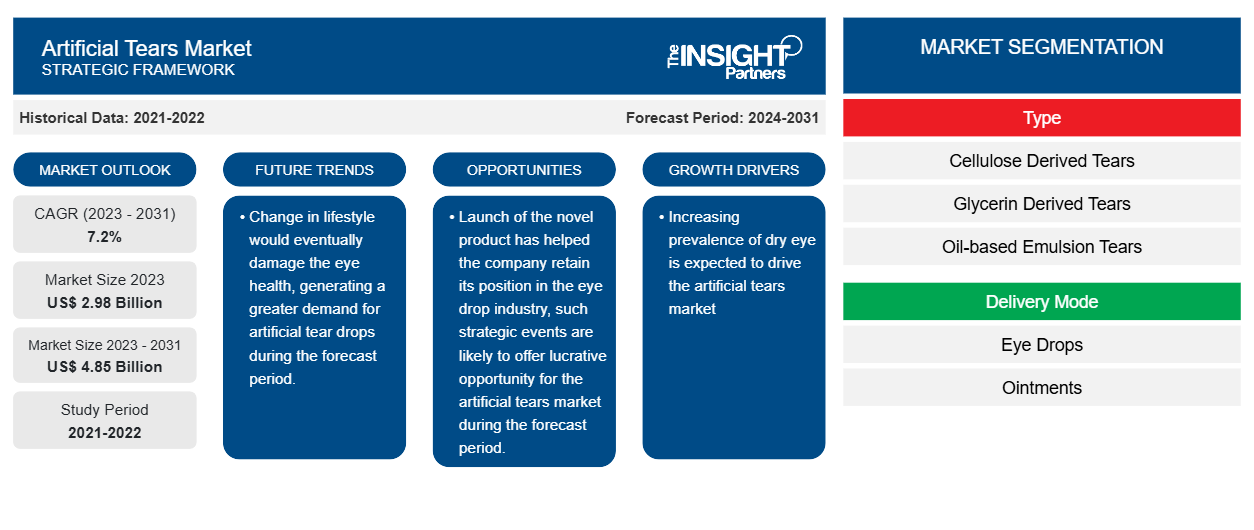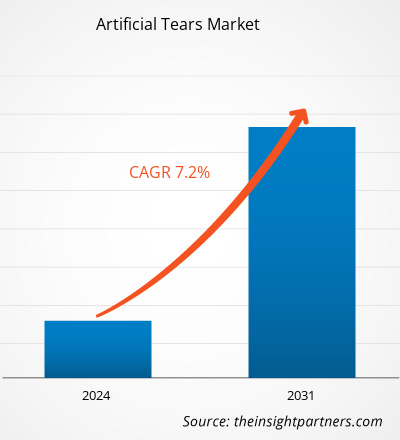The artificial tears market size is projected to reach US$ 4.85 billion by 2031 from US$ 2.98 billion in 2023. The market is expected to register a CAGR of 7.2% during 2023–2031. Lifestyle changes will likely remain a key trend in the market.
Artificial Tears Market Analysis
The rising incidence of dry eye and the growing older population are the key driving factors behind the market development. Furthermore, the increasing number of industrial developments is a crucial opportunity for the artificial tears market players.
Artificial Tears Market Overview
The incidence of dry eye is rising among the population, especially in developed nations. Dry eye is caused by multiple factors that result in discomfort, irritation, and visual disturbance. For instance, according to a study “National Health and Wellness Survey” conducted in the US in April 2020, ~16.4 million people were diagnosed with dry eye. The data also stated that the prevalence has increased by 2.7% among people aged 18−34 years. Additionally, the prevalence was 18.6% among older people. Based on sex, the prevalence percentage was higher in women; it accounted for 8.8% than in men with 4.5%. The dry eye incidence is higher among the European and Asia Pacific populations. Thus, the increasing prevalence of dry eye is expected to drive the artificial tears market.
Customize This Report To Suit Your Requirement
You will get customization on any report - free of charge - including parts of this report, or country-level analysis, Excel Data pack, as well as avail great offers and discounts for start-ups & universities
Artificial Tears Market: Strategic Insights

-
Get Top Key Market Trends of this report.This FREE sample will include data analysis, ranging from market trends to estimates and forecasts.
Artificial Tears Market Drivers and Opportunities
Growing Older Population
The incidence of dry eye is commonly seen in people aged 65 and above. The geriatric population is increasing rapidly worldwide. According to the 2019 revision of World Population Prospects, by 2050, one in six people will be over age 65, an increase from one in eleven in 2019. Furthermore, according to the same study, one in four people in Europe and North America is estimated to be over 65 by 2050. Moreover, people over 80 will reach 426 million by 2050, from 143 million in 2019. Aging is one of the prominent factors which weakens eye vision. Various healthcare companies design their products by focusing on the geriatric population. Older people's degeneration process is much faster, so they are highly prone to eye conditions. Therefore, the high prevalence of dry eye among the older population will likely encourage manufacturers to introduce new eye products, which, in turn, will contribute to the market's growth. Also, the development in the healthcare industry has increased life expectancy. Countries worldwide are adopting new techniques to treat older people safely and effectively. Therefore, the increased quality of life is decreasing the death rates, and the older population is significantly growing worldwide. This is expected to boost the growth of the market.
Increasing Number of Industrial Developments
The industry is witnessing many business activities that are generating a very lucrative growth opportunity for the market. The players in the industry are focusing on brand establishments and consolidating supply chain distribution channels to leverage their presence in the global market. For instance, in March 2020, Grafton Optical launched I-DROP MGD Viscoadaptive Tears that relieve severe chronic evaporative dry eye. I-DROP MGD is a preservative-free, artificial tear that helps relieve symptoms associated with evaporative dry eye for patients suffering from Meibomian Gland Dysfunction. It is the most advanced eye drop for hydrating and lubricating the cornea. In addition, the companies are working proactively to launch advanced products in the market. For instance, in March 2020, Alcon, the global leader in eye care, introduced SYSTANE HYDRATION Preservative-Free (PF) Lubricant Eye Drops for dry eye. It is used to relieve eye dryness and protect against further irritation.
Further, in October 2019, Allergan launched a new product line called Refresh Relieva lubricant eye. Launching the novel product has helped the company retain its position in the eye drop industry. Such strategic events will likely offer lucrative growth opportunities for the artificial tears market during the forecast period.
Artificial Tears Market Report Segmentation Analysis
Key segments that contributed to the derivation of the artificial tears market analysis are type, delivery, and application.
- Based on type, the artificial tears market is segmented into cellulose derived tears, glycerin derived tears, oil-based emulsion tears, polythylene glycol based tears, propylene glycol based tears, sodium hyaluronate based artificial tears. The glycerin derived tears segment held a most significant market share in 2023.
- Based on delivery mode, the artificial tears market is segmented into eye drops, ointments. The glycerin derived tears segment held a most significant market share in 2023.
- Based on application, the artificial tears market is segmented by dry eyes treatment, contact lenses moisture. The dry eyes treatment segment held a largest market share in 2023.
Artificial Tears Market Share Analysis by Geography
The geographic scope of the artificial tears market report is mainly divided into five regions: North America, Asia Pacific, Europe, Middle East & Africa, and South & Central America.
In North America, the US artificial tears market holds the region's largest share. The US is the largest and fastest-growing country in the North American region for the artificial tears market. The market is expected to grow due to increasing incidences of dry eye conditions or diseases. The country has various companies that offer multiple types of eye drops and lenses to treat dry eye conditions. Also, rising healthcare expenditure is influencing the growth of the country's market. According to the American Academy of Ophthalmology data for 2019, in 2012, the prevalence of dry eye conditions increased by 5.28% in all age groups. The percentage for females increased by 7.78%; in males, it increased by 2.96%.
Owing to the increasing percentage of people with dry eye, there is an expected increase in demand for artificial tears products. In addition, healthcare spending on dry eye treatment is rising in the country. For instance, an article published in JAMA Internal Medicine states that the government spends more than US$ 2 billion yearly to treat dry eye conditions.
Artificial Tears Market Regional Insights
The regional trends and factors influencing the Artificial Tears Market throughout the forecast period have been thoroughly explained by the analysts at The Insight Partners. This section also discusses Artificial Tears Market segments and geography across North America, Europe, Asia Pacific, Middle East and Africa, and South and Central America.
Artificial Tears Market Report Scope
| Report Attribute | Details |
|---|---|
| Market size in 2023 | US$ 2.98 Billion |
| Market Size by 2031 | US$ 4.85 Billion |
| Global CAGR (2023 - 2031) | 7.2% |
| Historical Data | 2021-2022 |
| Forecast period | 2024-2031 |
| Segments Covered |
By Type
|
| Regions and Countries Covered |
North America
|
| Market leaders and key company profiles |
|
Artificial Tears Market Players Density: Understanding Its Impact on Business Dynamics
The Artificial Tears Market is growing rapidly, driven by increasing end-user demand due to factors such as evolving consumer preferences, technological advancements, and greater awareness of the product's benefits. As demand rises, businesses are expanding their offerings, innovating to meet consumer needs, and capitalizing on emerging trends, which further fuels market growth.

- Get the Artificial Tears Market top key players overview
Artificial Tears Market News and Recent Developments
The Artificial Tears Market is evaluated by gathering qualitative and quantitative data post primary and secondary research, which includes important corporate publications, association data, and databases. A few of the developments in the artificial tears market are listed below:
- Sun Pharma launched its specialty ophthalmology therapy CEQUA in India to treat patients with dry eye disease (DED). (Source: Sun Pharma., Company Website, April 2023)
Artificial Tears Market Report Coverage and Deliverables
The “Artificial Tears Market Size and Forecast (2021–2031)” report provides a detailed analysis of the market covering below areas:
- Parenteral nutrition market size and forecast at global, regional, and country levels for all the key market segments covered under the scope
- Parenteral nutrition market trends as well as market dynamics such as drivers, restraints, and key opportunities
- Detailed PEST/Porter’s Five Forces and SWOT analysis
- Parenteral nutrition market analysis covering key market trends, global and regional framework, major players, regulations, and recent market developments.
- Industry landscape and competition analysis covering market concentration, heat map analysis, prominent players, and recent developments for the artificial tears market
- Detailed company profiles
Frequently Asked Questions
What is the expected CAGR of the artificial tears market?
Which are the leading players operating in the artificial tears market?
What are the future trends of the artificial tears market?
What are the driving factors impacting the carboxy therapy market?
Which region dominated the artificial tears market in 2023?
- Historical Analysis (2 Years), Base Year, Forecast (7 Years) with CAGR
- PEST and SWOT Analysis
- Market Size Value / Volume - Global, Regional, Country
- Industry and Competitive Landscape
- Excel Dataset
Recent Reports
Testimonials
Reason to Buy
- Informed Decision-Making
- Understanding Market Dynamics
- Competitive Analysis
- Identifying Emerging Markets
- Customer Insights
- Market Forecasts
- Risk Mitigation
- Boosting Operational Efficiency
- Strategic Planning
- Investment Justification
- Tracking Industry Innovations
- Aligning with Regulatory Trends





















 Get Free Sample For
Get Free Sample For